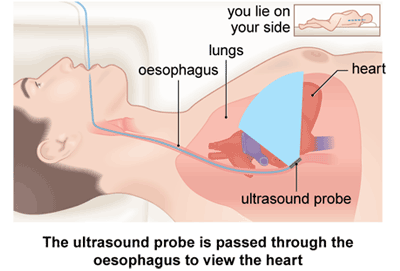A transoesophageal echocardiogram is a test that uses ultrasound to produce moving, real-time images of your heart. It can show the structure of your heart and how well it’s working.
A consultant can also use it as a guide if you’re having an operation on your heart.
In a transoesophageal echocardiogram, your doctor or sonographer will pass an ultrasound probe into your oesophagus. This is the pipe that goes from your mouth to your stomach.

Preparing for transoesophageal echocardiogram
A transoesophageal echocardiogram is usually done as a day-case procedure in hospital. This means you have the test and go home the same day.
Your doctor or sonographer will explain how to prepare for your procedure.
You might be asked not to eat or drink anything for about six hours before you have the procedure. If you’re taking any medicines, you’ll probably be fine to do so on the morning of your appointment with a sip of water. But check with your doctor. They should have asked you before the test if you’re taking any medicines that help to prevent your blood clotting, such as warfarin.
You’ll usually stay awake during the procedure although your doctor may give you a sedative. This relieves anxiety and will help you to relax.
What are the alternatives to transoesophageal echocardiogram
Alternatives to having a transoesophageal echocardiogram include the following.
- Echocardiogram (transthoracic echocardiogram – TTE). This involves a doctor or sonographer moving an ultrasound sensor over your chest to get pictures of your heart. You might be able to have this procedure if you have difficulty swallowing the sensor for a transoesophageal echocardiogram. But a standard echocardiogram produces less detailed images than a transoesophageal echocardiogram.
- Cardiac MRI scan. MRI uses powerful magnets, radio waves and computers to produce detailed images of the inside of your heart.
- Cardiac CT scan. This uses X-rays to create a three-dimensional image of your heart.
What happens during transoesophageal echocardiogram
A transoesophageal echocardiogram usually takes about 20 minutes.
You’ll need to undress to your waist and put on a hospital gown that opens at the front. You’ll also need to remove dentures or dental plates if you have them.
Sedatives are usually given through a fine tube (cannula) into a vein in your arm or the back of your hand. Your doctor or sonographer will monitor your heart rhythm throughout the procedure.
You’ll need to lie on your left-hand side on the bed. Your doctor or sonographer will spray a local anaesthetic into the back of your throat to numb it, and place the probe in your mouth. They’ll then ask you to swallow so they can pass the probe into your oesophagus. The test isn’t painful but it may feel uncomfortable when your doctor or sonographer passes the probe into your oesophagus. You’ll still be able to breathe normally while it’s in your throat.
The probe will send out sound waves and pick up the returning echoes, which are converted into pictures of the inside of your heart. These are displayed on a monitor and are constantly updated so the scan can show movement.
What to expect afterwards
You’ll need to rest until the effects of the sedative have worn off. This can take up to three hours. After that, you can go home when you feel ready but ask a friend or relative to drive you.
After a local anaesthetic, it can take a while for the feeling to come back into your mouth and throat. Don’t try to eat or drink anything until you can swallow normally. This may take half an hour to an hour.
Your doctor or sonographer might be able to talk you through the results of your transoesophageal echocardiogram straightaway. Or they’ll send the results to your doctor who will go through them with you at your next appointment.
Recovering from transoesophageal echocardiogram
Having a sedative can make you feel sleepy. You might find you’re not as coordinated as usual or that it’s difficult to think clearly. This should pass within 24 hours. In the meantime, don’t drive, drink alcohol, operate machinery or sign anything important.
You may resume your usual activities the day after your procedure because the effects of the sedative will have worn off by then.
Side-effects of transoesophageal echocardiogram
Side-effects are the unwanted but mostly temporary effects you may get after having the procedure.
You may have a sore throat for a day or two after a transoesophageal echocardiogram. Your throat may also bleed a little but this isn’t common.
Complications of transoesophageal echocardiogram
Complications are when problems occur during or after the procedure. Complications of a transoesophageal echocardiogram can include:
- Damage or a tear to your oesophagus
- An allergic reaction to the sedative – this can take the form of breathing difficulties or feeling sick
- Inhaling the contents of your stomach – this shouldn’t happen if you stop eating and drinking before the procedure
